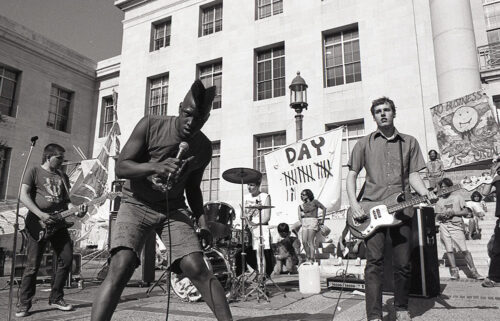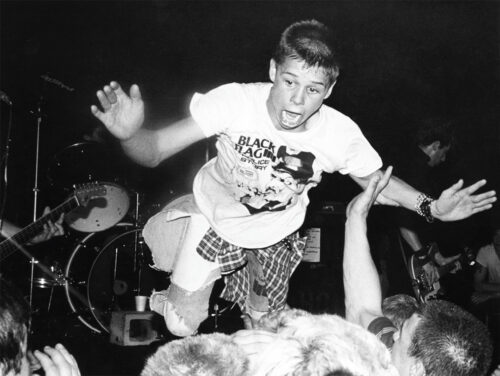
HAIL MURRAY! THE BAY AREA PUNK PHOTOGRAPHY OF MURRAY BOWLES 1982-1995
Edited by Anna Brown
Punks of the pre-internet age were good at sleuthing out information, tracking down new bands and finding meaningful connections between seemingly disparate groups of like-minded maniacs. My friends and I in the deep south, far away from coastal cultural meccas (insert RANCID quote here), traded notes about our hours spent pouring over liner notes, thank you lists, record label catalogs and photo credits. We made our own lists of the names that seemed to pop up over and over: Biafra, MacKaye, Vaucher…we cross referenced, dug deeper, looked west and further underground. MDC, MINUTEMEN, SEWER TROUT, OPERATION IVY, CRIMPSHRINE, NEUROSIS, BLATZ. The more we searched, the more we kept coming up with the same name: Murray Bowles. Seeing his vibrant photos helped us feel connected to something bigger than ourselves and showed us kindred spirits in places that felt worlds away.
Shockingly, Murray Bowles has only had one other collection of his work, in the MRR-published photozine from 1986, If Life Is a Bowl of Cherries, What Am I Doing in the Pit? Before his untimely death in 2019, he had started sorting out photos from his massive archives to make this book with his friend and editor, Anna Brown. After his passing, Brown grieved and moved forward with a small crew, combing through the archives to find essential shots that would help to tell a fuller story of the kind of Bay Area punk that Bowles championed throughout his life.
Murray seemed to be everywhere that cool stuff was happening in the Bay and this collection of his early work confirms that. From the Mab to the Vats to Gilman Street to infamous punk houses to donut shops to nameless warehouses and everywhere in between, Murray was there with his camera held aloft. Hail Murray! shows that he was often directly in the middle of the action, inches away from a boot to the face, or worse.
The book is laid out beautifully by Paul Curran. Unlike some other collections I’ve seen recently, it has a very clean look and doesn’t seek to overwhelm the reader with a sensory overload. Brown and Curran clearly exhibit a lot of love for Bowles’ work and many of the photos stand alone, so that you can really immerse yourself in all of the details of every image… and there is a lot to take in! It’s easy to get completely lost in every shot. I feel like each photo in here tells us a bigger story, answers questions, asks many more and even challenges assumptions we’ve all probably made about punk throughout our lives. Why does the singer of RIBZY have a cast on his arm? MINOR THREAT played in a basement on Valencia Street?? We already knew that the FEEDERZ threw a dead dog into the audience at Gilman, but did we need the photo of it? (Yes, we did). If all the old heads always talk about how the original hardcore scene was so dangerous and insane, why are people sitting on the ground during the MDC show? Who the hell is ELECTRIC SPAGHETTI?

The eye-opening introduction pointed out many facets of Bowles’ life that I was never aware of. Without giving too much away, Aaron Cometbus pens the kind of foreword that you always wish was in these larger punk retrospectives. Instead of securing the red velvet rope that leaves you outside of the party, he opens the side door to usher you in, pressing his still-wet stamp to the back of your hand. A rare interview with Murray from 2010, conducted by Brown and Cometbus is also included, which produced my only criticism of the book, albeit tiny: for the eternally curious, they never ask what kind of camera or film Bowles used during this era of his life (the answer: it was mainly a Nikon FE2 with a 28mm f2 lens and direct flash on Tri-X film exposed at ASA 400. Later, a Nikon N90).
Murray stayed with us in the underground because it was more interesting and exciting than the shows in larger venues. The book captures this with his candid shots from front yards, punk house kitchens, dogpiles on couches and smiling kids hanging out in the street. It shows the scope of a vibrant scene, documenting the interconnectedness and lack of barriers between audience and performer. He was much more interested in the unknown faces peeking out of the shadows or the new band opening the show than the crowd favorites. He showed the innate joy of punk and friendship. Until the very end, Murray documented the DIY punk scene with dignity, respect and a palpable love for the lives he captured in his lens.
I don’t envy the colossal task of sifting through his thousands and thousands of film negatives that he left behind, looking for the perfect shots for this book. I’m sure that the chorus of opinions about who or what should be included were sometimes deafening, but Anna Brown and her crew did an outstanding job with the parameters that they set for themselves. By approaching this in the same respect and eye for detail that Bowles graced his photo subjects with, Brown has created an astonishing and essential testament to the importance of Murray’s legacy to share with us all.

One last thing before I go. Like most good stories, I heard it third hand. As it goes, some young punks, way out in the suburbs of the South Bay in the 2010s, booked a show in their friend’s garage. On the day of the show, the turnout was very low… hardly any more people than the bands and a few of their friends. They were feeling dejected and unsure of everything. Guess who walked through the door in that moment, smiling, camera in hand? Just like that, they felt like something bigger than themselves. A continuation of the thread. Kindred spirits in worlds that felt closer than ever. They were a part of the ongoing story through Murray’s lens, and it meant everything.
